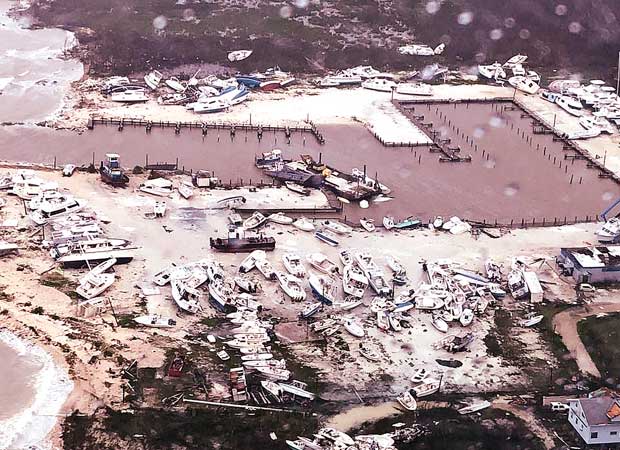BAHAMAS: Bahamians scrambled to escape the islands hardest-hit by Dorian, which has killed at least 43 people, while the monster storm churned northward and made landfall near Halifax, Canada, on Saturday.
A loosely coordinated armada of passenger planes, helicopters and both private and government boats and ships -- including redirected cruise liners -- converged in the Bahamas on the horribly battered Abaco Islands to help with evacuations, both to Nassau and to the US mainland.
Evacuees began flowing out of the region as a cruise ship carrying 1,400 people docked Saturday in Riviera Beach, Florida, CNN reported. All had documents to enter the United States.
More than 260 Abacos residents arrived Friday in Nassau on a government-chartered ferry, part of the first wave of people to be evacuated off the archipelago’s most decimated islands.
The Coast Guard said Saturday that all Bahamian ports had now reopened and that it had deployed nine cutters to the islands. Six of its MH-60 Jayhawk helicopters had so far rescued 290 people.
Even as some Bahamians began to reunite with their loved ones, Prime Minister Hubert Minnis said the death toll -- 35 so far in the Abacos and eight in Grand Bahama -- was likely to climb “significantly.”
Thousands of miles (kilometers) north, Canadians were hunkered down along the country’s Atlantic coast as Dorian, now classified as a post-tropical cyclone, made landfall south of the port city of Halifax, home to Canada’s Atlantic fleet.
“We’re talking about a very dangerous storm,” Bob Robichaud of the Canadian Hurricane Centre told a briefing.
Television images showed a downpour and howling winds in the empty streets of downtown Halifax where a crane collapsed onto an apartment building and more than 450,000 households in the region were without electricity after winds knocked down power lines.
Bahamas residents said conditions on the destroyed islands were brutal and that the smell of unrecovered bodies, along with mounting piles of garbage, was oppressive and unsanitary.
Hundreds or even thousands of people were still missing, officials said, as search-and-rescue teams continued their grim retrievals.
Meanwhile, Minnis said Nassau “cannot possibly accommodate” all the Abaco victims.
For now, he said, supplies of food and water were adequate, although several witnesses from Abaco contested that.
While the prime minister called the loss of life “catastrophic and devastating,” Health Minister Duane Sands said the final death toll “will be staggering.”
UN relief officials said more than 70,000 people on Grand Bahama and Abaco were in need of assistance. The WFP was sending food and supplies.
A UN World Food Program team estimated that 90 percent of buildings in Marsh Harbour were damaged.
The US Coast Guard, Britain’s Royal Navy and private organizations have been helping evacuate island residents to Nassau, hampered by damaged piers and airport runways.
Chamika Durosier was waiting early Saturday at the Abaco airport. The island, she said, was unsafe.
“The home that we were in fell on us,” she said. “We had to crawl -- got out crawling. By the grace of God we are alive.”
She described the increasingly desperate plight of those left behind. “People have no food. People have no water, and it’s not right. They should have been gone.
“Dead bodies are still around and it’s not sanitary.”
Dorian, a monstrous Category 5 hurricane when it raked through the Bahamas, was buffeting southwestern Nova Scotia with winds equivalent to those of a Category 2 hurricane.
Although it packed hurricane-force maximum sustained winds of 100 miles per hour (155 kilometers per hour), these were occurring primarily over water, the US-based National Hurricane Center reported. Storm surges were causing widespread flooding.
Prime Minister Justin Trudeau was briefed on the storm.
“The safety of Canadians is our number one priority and we’re ready to help Atlantic Canada through this storm,” he said on Twitter.
Officials also said Dorian had already dropped more than four inches (100 millimeters) of rain on Nova Scotia, which could double by Sunday morning.
Public Safety Minister Ralph Goodale said federal assistance was being provided.
The military was mobilized to deliver aid and help with evacuations, while roads and bridges in the region were closed.
“To those impacted by Hurricane Dorian, our Armed Forces will be there to aid you in this challenging time. Stay safe and listen to your local first responders,” Minister of National Defence Harjit Sajjan wrote on Twitter.
Overnight, Dorian was expected to track northeast through the Maritimes region with “destructive winds and heavy rainfall,” the Canadian Hurricane Centre said, passing near eastern Prince Edward Island around midnight, and then over the eastern Gulf of St. Lawrence waters and western Newfoundland by Sunday morning.
Earlier, Dorian brought flooding and power outages but no major damage to the coastal Carolinas and Virginia in the United States. - AFP



Add new comment